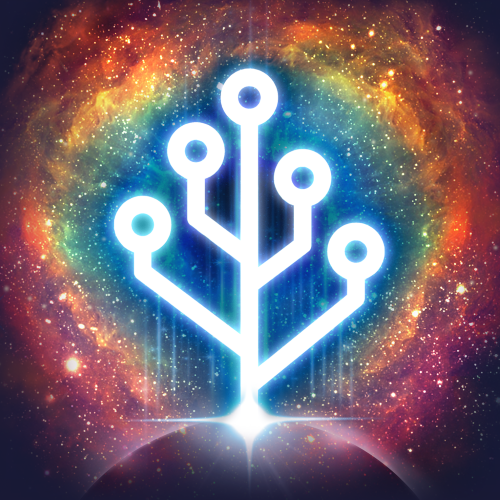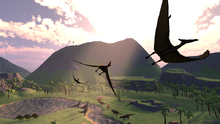The Pterosaur is the 6th Dinosaur obtained in the Mesozoic Valley Bubble Universe, which can generate Fossil. (Unlocked at Rank 4, branching off of Archosaur)
In Game Description[]
"Pterosaurs were the earliest vertebrates to evolve flight. They had leathery wings and came in a wide variety of sizes."
Traits[]
Common[]
- Wings (Speed):
"Pterosaurs were the first to develop this type of limb, which generates thrust and lift while moving through the air. Their leathery wings are closer to those of bats than the feathers of modern birds and later dinosaurs."
- Extended Finger (Payout):
"Pteranodon's leathery, bat-like wings were connected from their ankles to their extremely long fourth finger, giving them a massive wingspan that helped to power their flight."
Rare[]
- Parallel Evolution (Speed):
"Pteranodons, which were not dinosaurs, developed the ability to fly during the Triassic. Later, independently, some dinosaurs adapted the ability to fly as well. This is an example of parallel evolution, where two unrelated creatures develop the same trait."
- Carnivore (Payout):
"Animals that feed entirely on meat, or the flesh of other animals, are called carnivores. About half of dinosaurs were carnivores. With teeth specially designed for ripping and tearing, some carnivores were hunters, while others were scavengers."
- Triassic Age (Discount):
"The Triassic (251.9 MYA—201.3 MYA) was the first period of the Mesozoic Era. While the first half of this period was devastated by the Permian-Triassic Extinction Event, the second half is marked by increased diversity and the first appearances of dinosaurs."
Epic[]
- Hollow Bones (Speed):
"The development of hollow or semi-hollow bones gave some dinosaurs a lighter but stronger skeletal system. This development would later enable them to evolve the ability to fly."
- Herd Behavior (Payout):
"Some dinosaurs congregated in social groups, living in loose family units for defense against predators."
- Feathers (Discount):
"It is still unknown to what extent therapodian dinosaurs were feathered, but evidence exists that shows that at least some of them presented with varying degrees of feathery skin coverings."
- Warm Climate (Payout):
"During the Mesozoic Era, the Earth's temperature was very warm, which led to a great amount of geological and biological transitions. This climate set the stage for the major changes of the era."
Achievements[]
- Blood Brothers (75 Pterosaur):
"Despite their shared ancestry, Pterosaurs are not dinosaurs, but a variety of Archosaur."
- Baby Mine (200 Pterosaur):
"Juvenile remains and fossils of eggs have revealed the anatomical structure and growth of baby Pterosaurs, which may have been able to fly only days after they were born. These infants are called "flaplings" by paleontologists."
Wikipedia's Info[]
Pterosaurs (/ˈtɛrəsɔːr, ˈtɛroʊ-/; from Greek pteron and sauros, meaning "wing lizard") were flying reptiles of the extinct clade or order Pterosauria. They existed during most of the Mesozoic: from the late Triassic to the end of the Cretaceous (228 to 66 million years ago). Pterosaurs are the earliest vertebrates known to have evolved powered flight. Their wings were formed by a membrane of skin, muscle, and other tissues stretching from the ankles to a dramatically lengthened fourth finger.
There were two major types of pterosaurs. Basal pterosaurs (also called 'non-pterodactyloid pterosaurs' or 'rhamphorhynchoids') were smaller animals with fully toothed jaws and, typically, long tails. Later pterosaurs (pterodactyloids) evolved many sizes, shapes, and lifestyles.
Pterosaurs sported coats of hair-like filaments known as pycnofibers, which covered their bodies and parts of their wings. Pycnofibers grew in several forms, from simple filaments to branching down feathers.
Pterosaurs are often referred to by popular media or the general public as "flying dinosaurs", but dinosaurs are defined as the descendants of the last common ancestor of the Saurischia and Ornithischia, which excludes the pterosaurs.
Pterosaurs had a variety of lifestyles. Traditionally seen as fish-eaters, the group is now understood to have included hunters of land animals, insectivores, fruit eaters and even predators of other pterosaurs. They reproduced by eggs, some fossils of which have been discovered.

